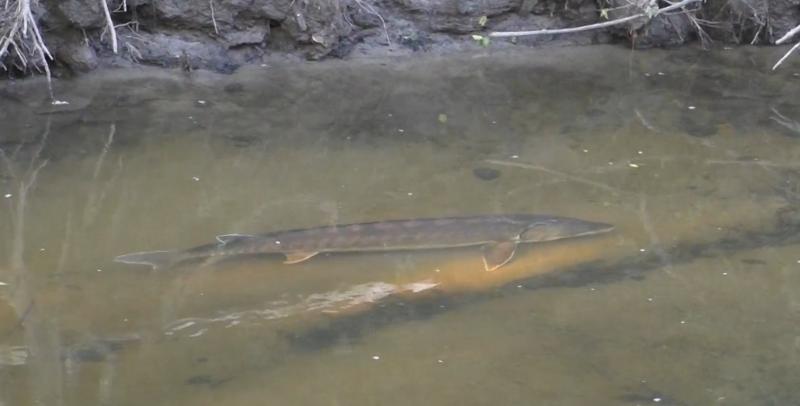A Fish out of Water
In North Carolina, concerned citizens reported a large fish stranded in a small pool in Green Springs Park in Greenville. A team of biologists mobilized quickly and found a massive armor-plated Atlantic sturgeon, measuring more than 5 feet long, right where the citizens reported it! These prehistoric fish are native to the nearby Tar River and are listed as endangered under the Endangered Species Act.
The biologists hypothesized that rains dumped by Idalia raised the water level in Greens Mill Run and the fish swam up the creek from the main stem of the Tar River. Unfortunately, as the waters receded, the sturgeon was stranded. Luckily, the biologists captured the fish and moved it back to the Tar River.
A Rescue with a Side of Science
The team’s greatest concern was determining how to safely move the animal from the pool back to the river. Hand-carrying a 5-foot-long, armor-plated fish nearly a mile back to the Tar River wasn’t an option. The water in the creek leading to the river was too shallow to use a boat to move the fish. So the rescue team had to get creative. They were able to catch the animal with a seine net and put it into a large cooler full of water from the creek. Then they used the cooler as an aquatic stretcher. They moved the fish from the creek to a large live well on their research boat still on its trailer, waiting nearby.
The team drove the boat, on the trailer, to a nearby boat ramp. From there, they launched the boat with the animal onboard and ferried it back to the Tar River, where it was released and swam away.
Before releasing the animal, the team took this rare opportunity to learn more about this fish. They weighed and measured the fish and collected a small fin clip and a fin ray. They also implanted a passive integrated transponder (PIT) tag after determining it did not already have one.
Genetic information provided from the fin clip will reveal which endangered population of Atlantic sturgeon this animal likely comes from. It may even reveal the specific river it hatched in and its sex. The fin ray collected is expected to provide information about its age.
The PIT tag is an internal microchip, similar to those implanted into pet dogs and cats, with a unique code. If the animal is ever recaptured, scientists can use a special scanner to detect and record the unique code from the PIT tag. The PIT tag will identify the fish as having been previously caught. Scientists can then look up the unique code to determine who first captured this individual. By working together and sharing information, scientists can estimate how the animal has grown or where it’s traveled between captures.
This animal may end up serendipitously providing valuable information about Atlantic sturgeon in the Tar River, a location with very little information about the species. While rescuing an animal in trouble isn’t ideal, scientists do use these rare opportunities to learn as much as they can.
Helping Animals in Distress is a Team Effort
This type of action takes a team effort to execute successfully. Charles Veith, a student at East Carolina University, first noticed the wayward fish. Students from the University's Ichthyology Laboratory kept an eye on the fish. And there was the concerned member of the public who ultimately reported the stranded fish to the North Carolina Wildlife Resources Commission. Once the Commission was aware of the fish, a whole new set of team members arrived on the scene, including Ben Ricks, Coastal Region Supervisor at the Commission. He first informed NOAA Fisheries about the animal and went to confirm it was truly an endangered Atlantic sturgeon.
A team of scientists mobilized to save the fish and move it back to the Tar River:
- North Carolina Wildlife Resources Commission (Nick Shaver)
- University of North Carolina-Wilmington (Dr. Fred Scharf and Jake Mathews)
- East Carolina University (Dr. Joe Luczkovich and Dr. Mark Sprague)
- NOAA Fisheries (Fritz Rohde)
We are grateful to our partners who helped us save the animal and especially those citizens who reached out and let us know about this sturgeon in trouble. Please call us to report an injured, stranded, or dead sturgeon at (844) STURG911 (844-788-7491). Do not attempt to rescue wildlife on your own. If safe, please stay with the animal, call trained responders, and provide as much information as possible about the animal and its location.
Endangered Species Act 50th Anniversary
The Carolina distinct population segment of Atlantic sturgeon are listed as endangered under the Endangered Species Act, which is celebrating its 50th Anniversary in 2023. This landmark legislation is a powerful and effective tool for conserving species and their habitats.
Under the Act, NOAA Fisheries is responsible for the protection, conservation, and recovery of more than 160 endangered and threatened marine and anadromous species. Learn more about the 50th Anniversary, our science and conservation programs, our partnerships, and the people who implement the Act.






